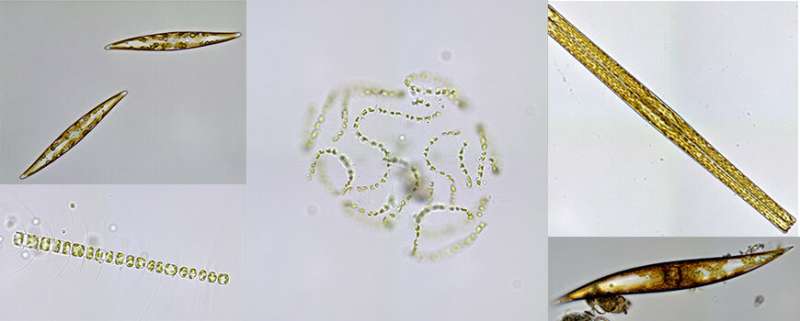A toxic chemical in marine ecosystems turns out to play a beneficial role

Advocates of healthy eating often extol the benefits of adding antioxidants to one's diet. These compounds are thought to suppress "free radical" molecules in the body that can age cells as a response to stress.
These destructive free radicals—known as reactive oxygen species—also exist in marine ecosystems and are thought to degrade the cells of phytoplankton and other organisms. A new paper, however, suggests that these molecules actually play a beneficial role, upending some conventional wisdom.
Julia Diaz, a newly hired marine biogeochemist at Scripps Institution of Oceanography at the University of California San Diego, and colleagues report that the reactive oxygen species produced by one type of phytoplankton, the diatom Thalassiosira oceanica, protects cells from overproduction of a compound that is used to power photosynthesis. In essence, that reactive oxygen species acts to protect cells' batteries from the effects of overcharging.
The study, "NADPH-dependent extracellular superoxide production is vital to photophysiology in the marine diatom Thalassiosira oceanica," appears July 22 in the journal Proceedings of the National Academy of Sciences.
"Our findings point to a new role for reactive oxygen species in the photosynthetic health of this diatom. The next challenge is to determine whether this process also exists in other phytoplankton species," said Diaz.
The findings could have implications for marine organisms and their chemical environment. The type of reactive oxygen species studied by Diaz is known as superoxide, which is a charged oxygen atom. Superoxide has been identified as a probable culprit in die-offs of fish and marine animals when toxic algae blooms spread in the ocean, suggesting a need for scientists to better understand how and why it is produced in certain circumstances. The varying positive and negative roles of superoxide could be a critical factor in how marine ecosystems respond to climate change. It is possible, Diaz said, that superoxide production could mitigate stress, which is a form of ocean resilience to changing climate that has not been understood previously.
Superoxide is present throughout ocean ecosystems but how it is used by diatoms like T. oceanica had been a mystery. They need sunlight and carbon to conduct photosynthesis and have a variety of ways to perform the task to adapt to either low or intense-light conditions. A compound they make called NADPH is the power source that lets them take up and "fix" carbon into carbohydrates. Very bright light can cause diatoms to overproduce NADPH.
After studying superoxide production in diatoms at various light levels, Diaz and colleagues concluded that, akin to a surge protector, making superoxide protects cells at times when too much NADPH is produced and restores balance to keep photosynthesis at peak efficiency.
Diaz, who joined the Scripps faculty as an assistant professor this month, performed this research as a postdoctoral scholar at Woods Hole Oceanographic Institution in Woods Hole, Mass., and as an assistant professor at the University of Georgia Skidaway Institute of Oceanography. Sydney Plummer, who also contributed to the study, will continue this research as Diaz's student in the Scripps Ph.D. program beginning this fall.
More information: Julia M. Diaz el al., "NADPH-dependent extracellular superoxide production is vital to photophysiology in the marine diatom Thalassiosira oceanica," PNAS (2019). www.pnas.org/cgi/doi/10.1073/pnas.1821233116
Journal information: Proceedings of the National Academy of Sciences
Provided by University of California - San Diego

















